Our affiliates

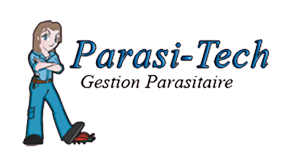




Our goal is to solve your pest problems with professionalism and use the best techniques to not leave residue and maintain a clean environment in your homes.
View coupons

• Wide , up to 1.8 inches long..
• The wings are orange-red .
• Orange abdomen with brown stripes.
• Nests are found during the spring.
• Most die in late autumn.
• Only the fertilized queens overwinter .
• Nesting – In sheltered places , eg tree trunks, bushes, sides of buildings , barns, attics, hollow walls. Their nests are gray and paper-like .
• A colony can reach a size of 700 workers.
• Only spades when provoked . Their stings are painful to humans. They can bite and sting at the same time . They can mobilize the entire nest to sting in defense which is very dangerous for humans.
• Food – Live insects and sap. Are not attracted by human food.

• 3/4 – 1 inch long .
• Female faces are black, male faces are yellow.
• Bright yellow , orange or white hairs on the thorax.
• No hair on the belly.
• Women have a stinger , men have no sting.
• Tunnel into wood to lay eggs.
• The life cycle from egg – larva – pupa – adult takes approximately seven weeks.
• Larva is large and noisy.
• New adults emerge from the nest late August
• Only sting if provoked .
• Visibility – late spring to mid-October .
• Nesting – the untreated softwoods are preferred, including redwood, cedar, cypress and pine . Old nests are used year after year.
• Location – Nests can be found in – between roofs, windows , trim, fascia , siding , decks and outdoor furniture .
• Power – flowers that contain pollen, eg Bradfords , daffodils , pansies . Pollen stored in abandoned tunnels for overwintering .
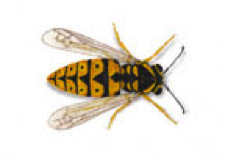
• Worker – 1/2 inch long .
• Queen – 3/4 inch long.
• A mix of black and yellow stripes .
• Two pairs of wings .
• Size narrow .
• Sting like a sword.
• Annual Colonies .
• The queen begins nesting in the spring.
• Very aggressive at the end of the summer.
• Colonies began to decline in the autumn.
• Only inseminated queens hibernate.
• Food – at certain times of the year they feed on insects , including caterpillars / pest flies , as colonies grow, they are attracted to foods consumed by humans.
• They bite repeatedly , they bite if provoked only. Symptoms range from swelling in allergic shock which is life threatening.
• Visibility – visible during the day because they do not see well at night .
• Nesting – in the trees / shrubs , or indoors in attics, hollow walls / flooring , sheds, under porches / between – roof buildings.
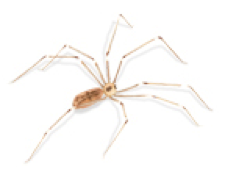
• 7-9mm long
• Characterized by having very long legs
• The female lays eggs , and can sometimes take its eggs in its palps ( short legs like structures attached to the front of the carapace between the teeth and the first pair of legs )
• They produce their canvas normally in sheltered areas , often in and around human habitation , including houses , garages and sheds
• Apart from the nuisance of their webs , they do no harm and are not toxic
• They are common in urban areas
• They feed on insects and other spiders
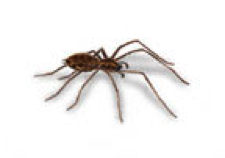
• Adult – body length excluding legs 1/4 « – 3/8 » . Yellow brown body with faint markings . Abdomen pale- brown and gray short hair .
• The egg sac produced by the female is spherical , covered with a layer of tissue and placed inside of the fabric structure .
• The male will mate several times with the woman before she died.
• Adults may live for several years.
• Find in buildings , sheds and walls.
• This spider produces a sheet of canvas.
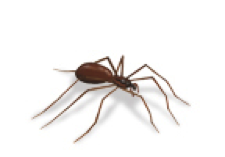
• 1/4 to 3/4 inch long.
• Colour brown or dark yellow .
• Slim, long brown legs covered with fine hairs .
• Six eyes, arranged in pairs in a semicircle.
• Eggs are laid primarily from May to July .
• The female lays about 50 eggs in a white silky sac off diameter about 2/3 inch.
• Spiders come out about 1 month later.
• It takes about a year to reach the adult stage.
• Adults can live 1-2 years
• Locations – They prefer isolated places, dark, undisturbed inside or outside sites. Inside, they can be found in attics, basements, closets, conduits, in storage boxes, shoes or behind furniture. Outwardly they can be found in barns, storage sheds, garages, under logs, loose stones and wood piles.
• Food – They prefer dead insects. They can survive about 6 months without food or water.
• Visibility – The sac serves to feed day. They tend to look for food at night.
• They only bite when crushed, handled or disturb. Both sexes are venomous. The reaction of a man to the bite depends on the amount of venom injected and the sensitivity of an individual – some people are unaffected, others may feel a sting, others a burning sensation, followed by intense pain. Some may not be aware of the bite for 2 to 8 hours.
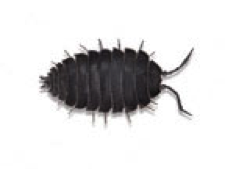
• Less than one inch long.
• Thorax has 7 pairs of legs and abdomen has 6 pairs of false legs .
• The color varies , but usually gray slate.
• Women carry the eggs attached to the underside of the body until the young hatch.
• One or two generations per year.
• In damp properties they will breed in decaying wood and other organic debris.
• Live under stones in cool, damp places. Adults live up to 2 years .
• Can invade properties when their habitat is dry or becomes flooded.
• Harmless , but may be objectionable in large numbers.
• Power – decaying vegetation and a few live plants .
• The sow bugs are eaten by many animals. Their main protection is rolled into a ball.
• They do not bite .
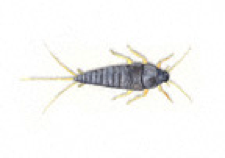
• 1/2 « long. Roadster shape with 3 long bristles at the end of the abdomen.
• Wingless with long antennae .
• silver-gray color .
• Eggs laid in crevices .
• Adults live for 1-3 years.
• Run quickly .
• Silverfish favor hot and humid conditions.
• Feed on food debris , and starches and are active at night .
• Pests minors kitchens, libraries and commercial premises .
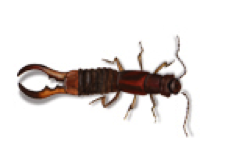
• 9/16 » -7/8 » long with forceps at the posterior end .
• The clips are curved in the male and straight in the female.
• Dark Black color .
• The female lays about 30 eggs in the soil .
• Female looks after eggs and young until they are ready to disperse.
• One generation per year.
• Adults are nocturnal and seek crevices and spaces for refuge .
• Earwigs are harmless but their clips may give a slight pinch .
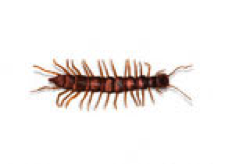
• 3/16 « -3 » in length pouches .
• Flattened body with many segments.
• Each segment has a pair of legs – 15-90 pairs of legs in total.
• Ramp occasionally in hidden places inside .
• Promotes damp places. Prone to loss of water because they have no waxy cuticle .
• Usually found outdoors but may crawl indoors for safety.
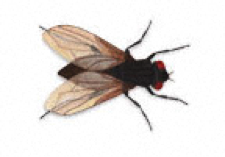
• Adult – 3/16 » -5/16 » long; thorax gray with 4 narrow stripes ; yellowish abdomen ; the tip slightly pointed wings .
• Larvae take 3-60 days to mature ; pupae 3-28 days.
• If the breed in damp and decaying plant matter
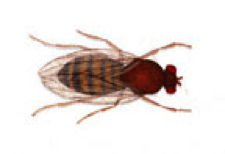
• 1/8 » in length. Yellow-brown or mottled in color with bright red eyes .
• Abdomen hangs the wheel, which is slow .
• Tend to hover.
• Adult lives for 2-9 weeks.
• May also breed in dirty sewers and cleaning utensils .

• 6-14 mm long
• Thorax is light gray and has 3 dark longitudinal stripes
• The abdomen is gray , speckled with dark spots to give a checkerboard appearance
• The female lays larvae on a suitable supply medium ( this can go rotten meat or fish or animal feces , or food rotting garbage found in the trash )
• The larvae feed for a few days, then moves away from the feed medium to pupate in dry areas adjacent
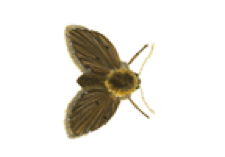
• 1/16 » in length.
• brown body appears gray.
• densely Wings hair and held tent-like over the body at rest.
• Larvae take 10 to 50 days to reproduce.
• Pupae 1-3 days maturity.

• Women are almost identical to the house fly, but males have an orange abdomen with black mark in the center.
• The female is approximately 1/4 « , and is generally larger than the male.
• Undergoing a complete metamorphosis with distinct egg, larva, nymph stages and adult
• The white eggs, about 1/32 « in length, are laid singly but pile up in small masses. Each female fly can lay up to 500 eggs in several batches over a period of three to four days.
• The life cycle can be complete within 12-20 days depending on temperature, with as many as 12 or several generations occurring during the summer.
• At night they rest on vegetation or artificial structures. Most of the day hours are spent feeding on plant sugars, the surface of manure deposits, or on animals.
• On host animals, they obtain protein nasal mucus, saliva and tears. The flies have microscopic « teeth » on their mouthparts, which are used to stimulate the flow of tears and aid this feeding process.
• They are excellent thieves and are capable of traveling several kilometers, but most remain in the vicinity of their breeding grounds.
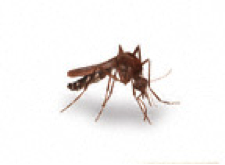
• Adult – thorax , legs and veins on the wings are always covered with brown scales . Drab . The end of the abdomen is always blunt.
• larval rest 45 degrees from the surface of the water
• Egg is brown , long and cylindrical , vertical on the surface of water, cemented in a raft of 300 eggs . Raft usually 1/8 « long and 1/16 » – 1/8 « wide.
• Complete metamorphosis – : egg, larva , nymph and adult
• They bite at night and usually remain within before and after they feed on blood . Sometimes they stay outside.
• Prefer dark colors
• Fly long distance
• Bearer illness Japanese B – Encephalitis

• Adult – light and dark spots on its wings and resting 45 degree angle to the surface.
• Larval remains parallel to the water surface
• The egg is 1/32 « long and has floats on the sides.
• Complete metamorphosis – : egg, larva , nymph and adult
• They bite at night and can stay inside and outside
• Prefers dark colors
• Woman with a blood meal can lay 50 to 150 eggs.
• Main Carrier Malaria

• The adult has black and white markings
• The larvae remain at 45 degrees to the water surface
• The egg is black and shaped like a rugby ball
• Complete metamorphosis – : egg, larva , nymph and adult
• They bite the change in light intensity ( after sunrise and before sunset)
• They prefer dark colors like red and black.
• Can fly short distance up to 100m .
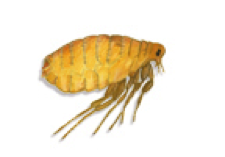
• Fleas are black to brownish non-winged.
• Adult chips are 1/32 « -1/8 » long.
• They have a long thin trunk which is used to pierce the skin of their host to feed on their blood.
• They have a characteristic jumping movement.
• The smooth oval eggs light color measuring about 0.5 mm long, are deposited on, but not firmly attached to the body, bedding, or the host nest.
• The adult generally emerges in a week or two after completing a larval and pupal stage, but under unfavorable conditions, the pupal period may be as long as a year.
• As they move from one host to another, they present a risk of disease transmission.
• Human Fleas can also be found on animals such as dogs, rats, pigs, deer and foxes.
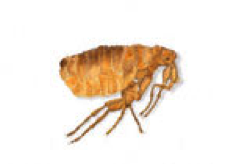
• Adult is brownish black, but looks reddish-black after a blood meal.
• Adult chips are 1/32 « -1/8 » long.
• The legless larva is off-white and can measure up to 3/16 long.
• The larvae are longer than the adults and feed on particles of dried blood, excrement, and organic substances collected in the infested premises.
• The body is laterally flattened, which allows it to move easily in the fur of an animal. Spines projecting backwards from the body of the chip, help him stand on the host animal during grooming.
• The dog flea is a vector of dog tapeworm, Dipylidium caninum, which can also affect humans.
• As they can jump approximately 6 inches, they can move from host to host. They can also infest lawns of the garden.
• A flea infestation can affect the general well-being of your pet, cause itching, redness, hair loss, severe skin infections or allergies to flea saliva.

• 1/16 « -1/8 » non-winged long.
• Flattened from one side to the other.
• Have long legs enabling them to jump.
• The stages combined ranging from 2 nd to 8 weeks.
• The adult flea is awakened by the detection of vibration of pet or human movement, pressure, heat, noise, or carbon dioxide to eventually eat with blood.
• A cat flea can not complete its life cycle on human blood.
• The stages combined ranging from 2 nd to 8 weeks.
• The adult flea is awakened by the detection of vibration of pet or human movement, pressure, heat, noise, or carbon dioxide to eventually eat with blood.
• A cat flea can not complete its life cycle on human blood.

• 3/16 « long.
• Oval and flattened from the back underneath the well-developed legs , but wings absent .
• mouthparts adapted for piercing and sucking .
• Red color brown
• Found in cracks and crevices , the headboards , behind peeling wallpaper , broken plaster , light switches, under carpets and skirting boards etc.
• Bed bugs are nocturnal .

• Glossy red-brown .
• Wings longer than the body in male ; women ‘s wings cover the abdomen.
• Courses ( can fly at very high temperature) .
• Nocturne.
• Omnivore .
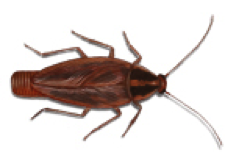
• Brown with two dark stripes on the thorax.
• The wings are as long as the body or slightly overlapping in both sexes
• Courses and climbing ( sticky pads on the feet) .
• Nocturne.
• Omnivore .

• Male 1/8 « long, black and winged .
• Queens 1/8 » -1/4 » long , dark red with wings.
• Black and 2 small segments at the stem ..
& Nbsp;
• characteriscs swarming – new colonies are often formed through nests that have been disturbed eg following treatment with insecticide spraying. Each queen produces up to 3500 eggs in her lifetime.
• Nest locations – deep-rooted in hollow in heated buildings. Often found in hospitals associated with humid conditions. Colonies can range from a few dozen to 300,000 ants.

• 1/8 « long
• 6 legs
• 2 spines on the back.
• 2 nodes on petiole.
• Indentations on the chest and head
• Thorax uneven with a pair of spines.
• Winged ants are often mistaken for termites.
• Visibility – seen entering houses in search of food , usually at night. Can move through pipes and electrical son .
• Nesting – in lawns or under stones , wood, or advice. Mounds built along sidewalks , baseboards, and near foundations. Colonies found near water.
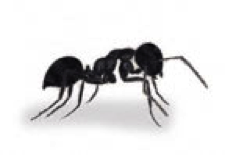
• Larvae feed on secretions from the salivary glands of the queen until the first workers emerge.
• Workers continue with care of larvae, nest building and foraging.
• Fertile males are produced later in the season.
• Swarming characteristics – mating between queens and fertile males takes place on the wing mid to late summer. Males die after mating.
• Nest locations – often outdoors in soil and below paving slabs on the sunny side of buildings. Nest locations can be identified by the presence of finely powdered around nest exit holes soils.
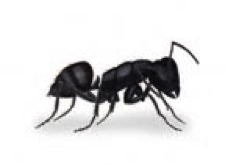
• The colonies of carpenter ants can live from 3 to 6 years.
• Interior – tunneling into the wood with a smooth appearance.
• Exterior – sometimes digging sections of trees.
• Visibility – hunt for food mainly at night but in the early spring / summer. Signs include sawdust, wet wood, or unusual noises coming from the walls.
• Food – staple food is honey melon, they also eat plant secretions, fruit juices and insect remains. They do not eat wood. In homes, they are attracted to sweet substances, fats and meats.
• Contact – they rarely come into contact with people, but if they are in touch they will try to escape.

• Up to 15 3/4 » in length, with a tail shorter than the head and body.
• 350 – 500g in weight.
• flat nose , small ears and a thicker body compared to the Black Rat (Rattus rattus) .
• 3-week gestation period .
• 10 to 12 weeks from birth to sexual maturity.
• Food is favorite cereals.
• They eat about 30g of food a day and drink 60 ml per day.

• 2 3/4 » – 3 3/4″ in length , with a tail around the same length.
• 12 – 30g in weight.
• Their little feet and head and large eyes and ears distinguish them from a young brown rat (Rattus norvegicus) .
• 3-week gestation period .
• 8 to 12 weeks from birth to sexual maturity.
• Favorite food are cereals .
• They eat around 3 g of food per day and can survive without additional water. They drink up to 3 ml a day if their diet is particularly dry .

• Black and yellow abdomen .
• Workers ( sterile females ) appear in early summer and take over nest building . The Queen continues to ponder eggs.
• New queens and males mate in early fall .
• Nest dies during winter, including all the males and workers . Only the queens survive the next year.
• Preferred nest sites – lofts, wall cavities , old rodent burrows , hollow trees and bushes
• Nest construction – treated wood ( paper ) . Combes placed horizontally . A new nest is produced each year.
• Power – insects and sweet food.
• bite easily and often.